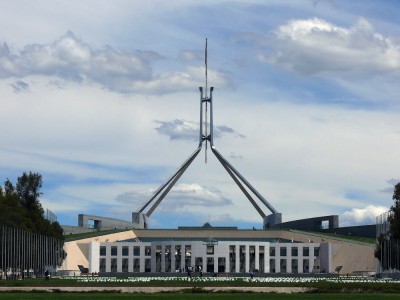Illusion looms large in the vast halls of power that make up Parliament House, Canberra, and it shows in the debate over emissions trading. Our politicians need a heavy dose of reality to make this scheme work, but we shouldn’t hold our breath. [24 November 2009 | Peter Boyer]
There’s something surreal about political life in our national Parliament House, that remarkable building in which politicians, having left their homes and families in far-flung parts of Australia, gather to pass the laws that shape our country.
For about 70 days each year, the Parliament comes alive with their talk and their meetings, their wrestling with policies and bills, their plotting and manoeuvring and lobbying, their worries about preselection and electorate boundaries and the dreaded polls — all in the name of democracy.
Last week I was able to experience personally this strange, detached world, in which things are never quite as they seem.
In a series of meetings, I enjoyed stimulating exchanges with some intelligent and informed members and senators. I also got some disconcerting reminders that whatever facts and principles may be in play at any time, politics is above all about gaining and retaining power.
I was in Canberra representing the Climate Project in a coalition of groups concerned about the gravity of the climate challenge and the need to take a strong position into the Copenhagen summit next month, and seeking to pass this concern to politicians as they debate emissions trading.
Like any lobbyist, I was trying to get into the ear of politicians to get their support for my interest, but with a difference. Most Canberra lobbyists are experienced representatives of business interests with deep pockets. We were from volunteer groups, anything but well-heeled, and we’d never done this sort of thing before.
This was a very steep learning curve. Apart from some intense training in the arcane art of lobbying, coming from different organisations we also had to define precisely the message we wanted to get across to our politicians and how we wanted them to express this in the chamber.
When we got into the offices and spoke to these MPs and senators, we discovered a little of the complexities of life in coal-mining and farming electorates, bedevilled by misinformation campaigns against any action on emissions.
It’s a tough battle trying to get national agreement on reducing the amount of greenhouse gas we put up into the sky. Not being a natural scrapper, I don’t envy Penny Wong and her opposition shadow, Ian Macfarlane, as they talk themselves hoarse trying to reach some sort of agreement to get what they both want – an emissions trading scheme.
They both want it because for them the Carbon Pollution Reduction Scheme is the big ticket item that gets a monkey off their backs. For them, it represents action on climate change, after which they can tell their electors, “We do care. We have acted.”
The CPRS represents a lot of thinking and talking and dealing, but action it most certainly is not – at least, not in the form presented to the Parliament last week. CPRS or no CPRS, the planet will go on warming and Australia’s emissions will continue unabated.
Why does the government support so many billions of dollars of “relief” for the big carbon-intensive polluters? Why does the CPRS allow these businesses unlimited access to offsets in foreign countries to avoid having to cut back on their own carbon pollution?
How does the government justify the pathetic 5 per cent minimum reduction target? Why, under this legislation, do the efforts of individuals and communities to reduce emissions go unrecognised, serving only to provide scope for yet more emissions from the big polluters?
And why does the opposition (apart from those who regard continued polluting as an inalienable right) argue that this isn’t enough; that we should go still further to anaesthetise business and agriculture – on top of motorists – from feeling any impact at all from their emissions? What sort of carbon price signal does this send to us, out here?
Neither major party expects the CPRS to start bringing down our carbon emissions any time soon. To them it’s a framework within which something effective will grow over time. That is the big point of difference with the Greens, for whom the CPRS is a useless edifice that in coming years will cost taxpayers many more billions, to zero effect.
What will the bill’s passage do for Australia’s position in Copenhagen? The opposition says that, unamended, it will put us in an exposed position and allow foreign business to undercut our own. Government members I met with say it’s courageous legislation that will show Australia’s determination to cut emissions in a domestic environment that’s far from favourable.
Neither position holds water. Carbon-intensive business will do very nicely out of the CPRS bill’s taxpayer subsidies (so much for a free market!), and no-one in Copenhagen, unless they hang on our prime minister’s every word, will see the CPRS as anything more than a diplomatic tool of doubtful value.
In Canberra, our lobbying coalition only got to meet politicians who supported some action on carbon emissions; the opposing minority declined to meet us. We told our hosts that, with dangerous tipping points now upon us, they should feel confident about the long-term support of Australians for a stronger emissions trading scheme that brings prompt, effective action.
But for all that, I took away the distinct impression that politicians considered us “unrealistic”. We got no dispute about the physical reality of climate change; we just needed to accommodate “political reality”. This, from the inhabitants of that dream castle on Capital Hill.

